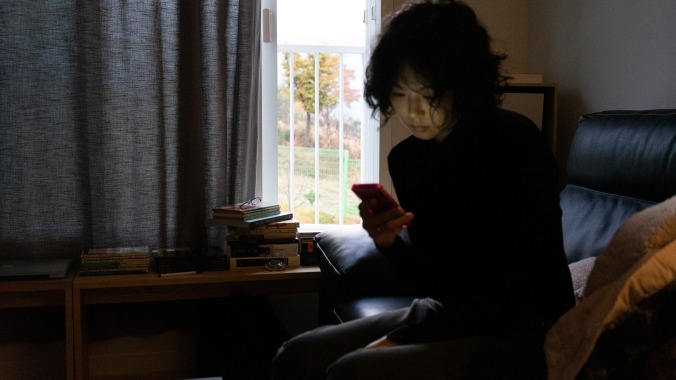The Woman Who Ran glows with glimmers of a summertime masterpiece
Hong Sang-soo pays tribute to the great Éric Rohmer with this searching drama
Film Reviews The Woman Who Ran

South Korean director Hong Sang-soo has long drawn comparisons to the great Éric Rohmer. This is understandable, as both filmmakers spin seasonal variations on similar material, frequently offering talky plots centered around romantic entanglements and chance encounters. But their affinities are ultimately more thematic than stylistic: In particular, Hong’s formal and conceptual interventions—such as his very conspicuous use of zooms and structural plays with narrative—tend to be far more upfront than the French director’s. Still, as a starting point, the comparison is often useful, perhaps especially so for Hong’s latest, The Woman Who Ran, an unassuming but richly suggestive portrait of a lonely vacationer.
The most revealing reference point, in this case, is Rohmer’s 1986 masterpiece The Green Ray, whose solitary heroine whiles away her summer across three French locales, her actions seemingly dictated by a desire not to have anything memorable happen to her. (Hong listed the Rohmer classic on his 2012 Sight & Sound ballot of the greatest films of all time.) In The Woman Who Ran, we likewise follow a young woman on what looks like a pretty unremarkable vacation. Traveling alone for the first time since getting married, Gam-hee (Kim Min-hee, Hong’s real-life partner) reconnects with a trio of women from her past, the encounters dividing the runtime into three more-or-less equal parts. Their conversations, though, mainly extend Hong’s committed, some might say perverse focus on the mundane. As in The Green Ray, narrative incident is almost entirely eschewed.
It’s significant, then, that the most conventionally dramatic scenes of The Woman Who Ran all arise from chance encounters. Improvisation has become increasingly important to Hong’s cinema over the years, and here it becomes both a thematic and stylistic principle. The first two sections each see a rather pathetic, belligerent man (a familiar Hong type) intrude on Gam-hee’s meetings, while the third observes an unexpected run-in with her ex (Kwon Hae-yo), and a long conversation with his current partner (Kim Sae-byuk). What’s notable, though, is how Hong places the emphasis not on the narrative function of any given conversation but on its emotional tenor and improvisational rhythms. The antagonistic, go-nowhere exchanges involving the men are ostensibly more “dramatic” than the more conciliatory ones between the film’s women. But Hong’s presentation highlights their textural (as opposed to functional) similarities: The latter seem not so much undramatic as anti-dramatic, perhaps making us realize how limiting our notions of drama are to begin with. (That there’s a clear gender divide in the conversations also adds another layer about what we do or don’t consider worth watching.) To put it another way, the question we are led to ask during any given scene of The Woman Who Ran is not, “What does this event mean?” but “What does it mean to consider this an event at all?”
This, too, was a major aspect of The Green Ray, whose famous closing scene hinged, after all, not on any human conflict but on the observation of an optical phenomenon. And though The Woman Who Ran differs greatly in terms of style, it retains that film’s preoccupation with the natural world. One of its very best passages observes an argument with a stubborn neighbor about feeding stray felines. Instead of resolving dramatically, the scene culminates with a very funny zoom onto a cat that wanders into frame. Like the image of potted plants near the end of Hong’s Grass, it’s a reminder of how nature is essentially indifferent, but also how we nonetheless pull it into our dense tangle of human concerns.
As Gam-hee converses with different women from her past, we are presented with myriad ways of charting one’s path through the world. Hong’s playful formal moves, for their part, remind us how much of our lives are regulated by conventions that we don’t often think to question. When we start doing so, however, we allow ourselves to see daily life as a ceaseless act of improvisation—which can be terrifying. But it can be liberating, too, reminding us that “beauty” is not some fixed category outside ourselves; it’s always open to new ways of looking, to renewal and change. And as the closing passage of The Woman Who Ran suggests, with a flash of color recalling The Green Ray, perhaps helping us realize this is what art, and cinema, is for.
1 Comment
I unabashedly love Right Now, Wrong Then. Interested in this.